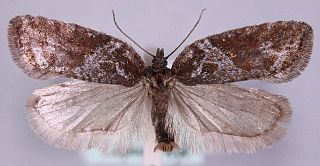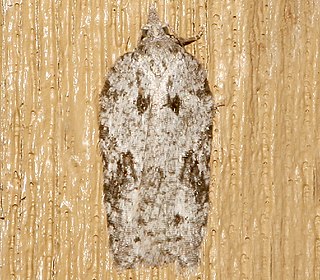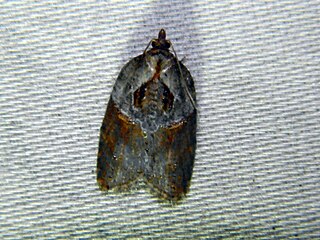
Acleris abietana, the Perth button, is a species of moth of the family Tortricidae. It is found in Europe, where it has been recorded from Great Britain, Ireland, France, Belgium, the Netherlands, Germany, Denmark, Austria, Switzerland, Italy, the Czech Republic, Slovakia, Slovenia, Poland, Hungary and Russia. The habitat consists of coniferous woodlands.

Acleris arcticana is a species of moth of the family Tortricidae. It is found in Norway, Sweden, Finland, Greenland and North America, where it has been recorded from Ontario, Illinois and Wisconsin.

Acleris ptychogrammos is a species of moth of the family Tortricidae. It is found in North America, where it has been recorded from Alabama, British Columbia, Illinois, Indiana, Kentucky, Maine, Manitoba, Maryland, Massachusetts, Michigan, Mississippi, New Hampshire, New York, North Carolina, Ohio, Oklahoma, Ontario, West Virginia and Wisconsin.

Acleris nigrolinea is a species of moth in the family Tortricidae. It is found in North America, where it has been recorded across Canada from British Columbia to New Brunswick, and in the United States as far south as California, Arizona, Tennessee and North Carolina.

Acleris maximana is a species of moth of the family Tortricidae first described by William Barnes and August Busck in 1920. It is found in North America, where it has been recorded from Alberta, British Columbia, California, Maryland, Massachusetts, Michigan, Montana, New Brunswick, North Carolina, Ontario, Pennsylvania, Saskatchewan, Tennessee, Utah and Washington.

Acleris caliginosana is a species of moth of the family Tortricidae. It is found in North America, where it has been recorded from Alberta, British Columbia, California, Colorado, Idaho, Maine, Montana, New Brunswick, Nova Scotia, Ontario, Quebec, Washington and Wisconsin.

Acleris chalybeana, the lesser maple leafroller moth, is a species of moth of the family Tortricidae. It is found in North America, where it has been recorded from Arkansas, Connecticut, Florida, Illinois, Indiana, Kentucky, Maine, Maryland, Mississippi, New Hampshire, New Jersey, New York, North Carolina, Ohio, Ontario, Pennsylvania, Quebec, South Carolina, Tennessee, West Virginia and Wisconsin.

Acleris celiana, Celiana's Acleris, is a species of moth of the family Tortricidae. It is found in North America, where it has been recorded from Alberta, British Columbia, Illinois, Maine, Massachusetts, Michigan, Minnesota, New Brunswick, New Hampshire, North Carolina, North Dakota, Ontario, Quebec, Virginia and Wisconsin.
Acleris flavivittana, the multiform leafroller moth, is a species of moth of the family Tortricidae. It is found in North America, where it has been recorded from Georgia, Illinois, Indiana, Kentucky, Maine, Maryland, Massachusetts, Michigan, New Brunswick, New Hampshire, New Jersey, New York, North Carolina, Ohio, Ontario, Pennsylvania, Quebec, Tennessee, Vermont, Virginia, Washington, West Virginia and Wisconsin.
Acleris youngana is a species of moth of the family Tortricidae. It is found in North America, where it has been recorded from Alabama, Maine, New Hampshire, Ontario, Pennsylvania, Quebec, Vermont and West Virginia.
Acleris fragariana is a species of moth of the family Tortricidae. It is found in North America, where it has been recorded from Alberta, California, Maine, Minnesota, New Hampshire, New York, Ontario and Washington.

Acleris inana is a species of moth in the family Tortricidae. It is found in North America, where it has been recorded from Alberta, Kentucky, Maine, Missouri and Ontario.
Acleris busckana is a species of moth of the family Tortricidae. It is found in North America, where it has been recorded from Maine, Manitoba, Massachusetts, New Brunswick, New Hampshire, Ohio, Ontario, Quebec and West Virginia.

Acleris maculidorsana, the stained-back leafroller moth, is a species of moth of the family Tortricidae. It is found in North America, where it has been recorded from Arkansas, Florida, Georgia, Kentucky, Maine, Maryland, Massachusetts, Michigan, Mississippi, New Jersey, North Carolina, Ohio, Ontario, Pennsylvania, South Carolina, Tennessee, Virginia and Wisconsin.
Acleris hudsoniana is a species of moth of the family Tortricidae. It is found in North America, where it has been recorded from Alaska, Alberta, Indiana, Maine, Manitoba, Massachusetts, Michigan, New Hampshire, New Jersey, Ontario, Saskatchewan, West Virginia and Wisconsin.

Acleris cervinana is a species of moth of the family Tortricidae. It is found in North America, where it has been recorded across Canada from British Columbia to New Brunswick and south to California and Alabama in the United States.
Acleris braunana is a species of moth of the family Tortricidae. It is found in North America, where it has been recorded from Alberta, British Columbia, Indiana, Maine, Michigan, New Brunswick, New York, Nova Scotia, Oregon, Pennsylvania, Quebec, Saskatchewan, West Virginia and Wisconsin.
Acleris kearfottana is a species of moth of the family Tortricidae. It is found in North America, where it has been recorded from Maine, Ontario, Pennsylvania, Quebec and West Virginia.
Acleris semiannula is a species of moth of the family Tortricidae. It is found in North America, where it has been recorded from Alberta, British Columbia, Illinois, Maine, Maryland, Mississippi, New Brunswick, New York, Ohio, Ontario, Pennsylvania, Quebec, South Carolina, West Virginia and Wisconsin.
Acleris cornana is a species of moth of the family Tortricidae. It is found in North America, where it has been recorded from Alberta, British Columbia, Illinois, Indiana, Kentucky, Maine, Manitoba, Maryland, Michigan, Minnesota, New Brunswick, New York, North Carolina, Ohio, Ontario, Quebec, Vermont, Washington and Wisconsin.











